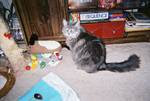(Body Condition Score is a measurement veterinarians use in addition to body weight, in order to assess whether a pet is too heavy, too thin or just right for their frame. See links at the bottom of the page.)
 |
| Before - A bit Round, 21.3#! |
 |
| After - Thinned Down, 11.7#! |
Weight loss was discussed during the exam and she had no other health concerns at that time. Then in June, Belle began to have issues with constipation and gastritis. Like many overweight cats, Belle stopped eating which actually made her sicker. Xrays and an ultrasound revealed that Belle had hepatic lipidosis, or "fatty liver."
Hepatic lipidosis is a disease that occurs when overweight or obese cats stop eating due to an underlying cause. This cause can be as innocent as a stressful situation to as devastating as cancer. In Belle's case, we suspected stress related gastritis (stomach upset) leading to a loss of appetite. "The modern house cat has every opportunity to become overweight and while this may not be of disastrous consequence on a day to day basis, should the cat get sick or lost and stop eating, a very big problem erupts. The fat stores mobilize. Normally, in starvation fat is moved from the body's storage depots to the liver for processing into lipoproteins but the feline liver was never intended to handle huge amounts of mobilized fat. The liver becomes infiltrated with fat and fails" (Wendy C. Brooks, DVM, DipABVP , VIN Pet Health Library).
Hepatic Lipidosis is only one of many health issues that can occur in overweight pets. Luckily for Belle, her owners took her nutrition plan very seriously and she was able to safely lose 10 pounds over 2 years. Belle's weight goal and a body condition score of 5/9 was mainly achieved by implementing a twice daily feeding schedule and measuring her caloric intake. Calories in must be less than calories out! It sounds easy, but can be overwhelming for many pet owners. When beginning a weight loss plan for your pet, it is best to seek the advice of your veterinarian. They can help you set realistic, healthy targets and ensure that your pet is eating a diet that is appropriate to their individual health needs.
Below is a guideline for calculating caloric intake for gradual, healthy wt. loss:
{(Your Pet's Body Weight in Pounds X 15) + 70 } x 0.80 = _____ kcal daily for wt. loss
Below is a guideline for calculating caloric intake for maintenance once target is reached:
(Your Pet's Body Weight in Pounds X 15) + 70 = ______ kcal daily for maintenance
Charts to evaluate your pet's Body Condition Score (click on links below):
Cats
Dogs
*If you would like more information or to schedule a nutrition evaluation and consult for your pet, please give us a call: 503.285.2337
No comments:
Post a Comment